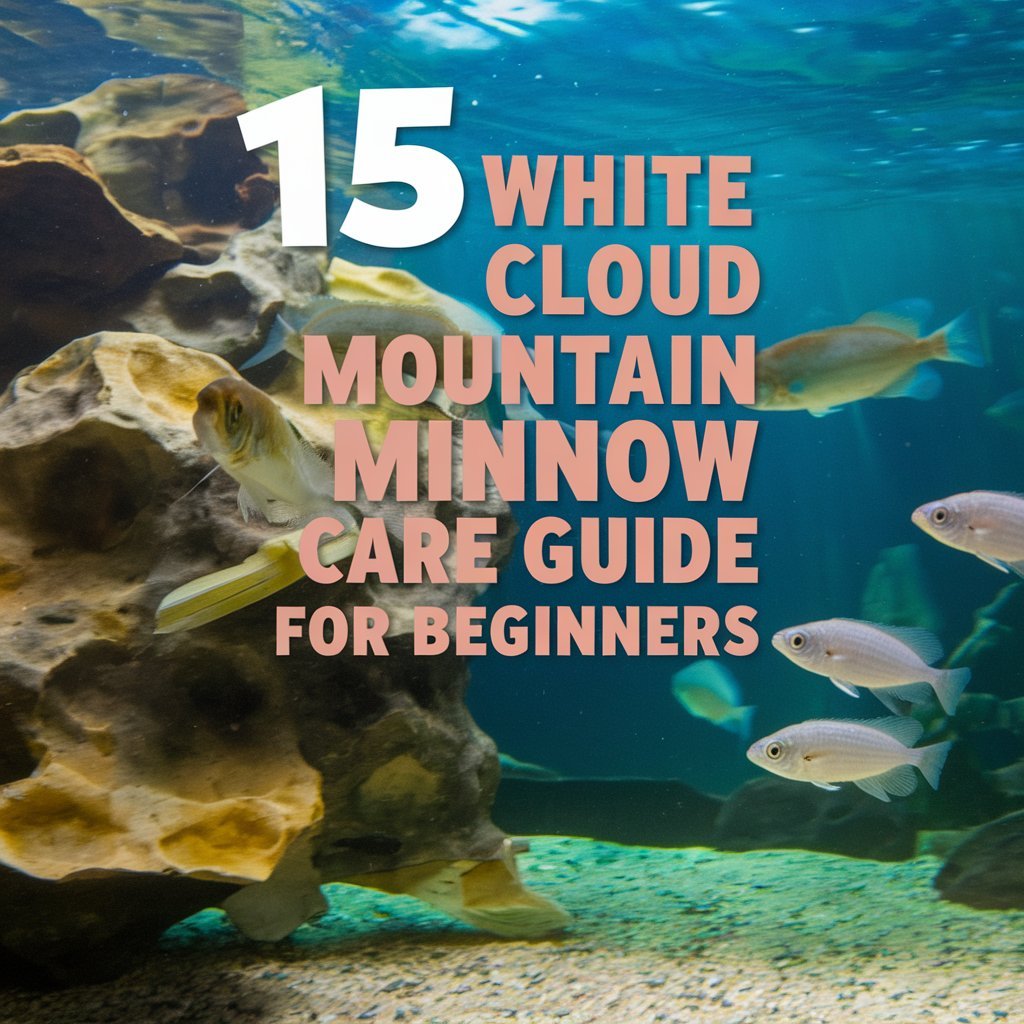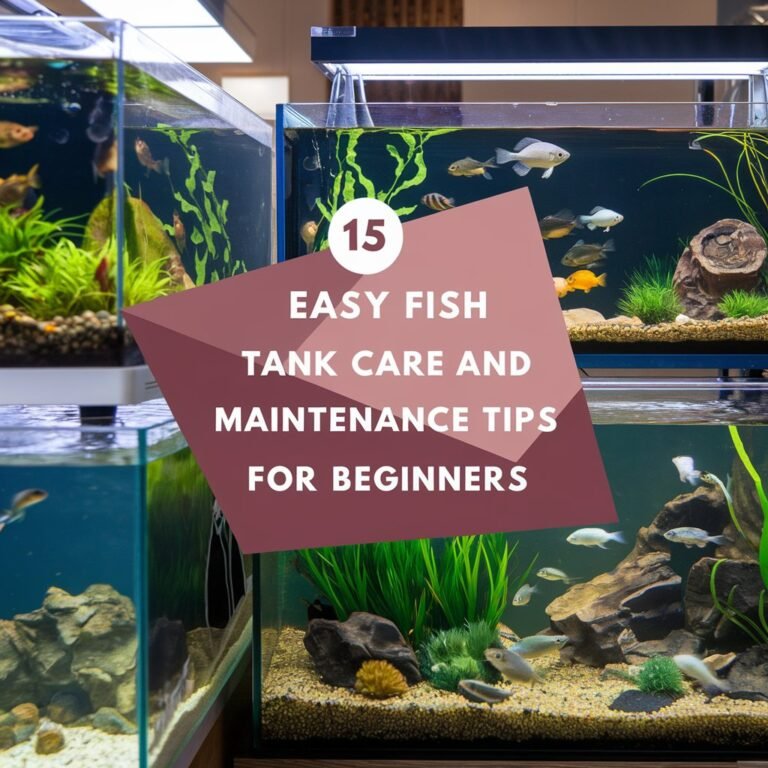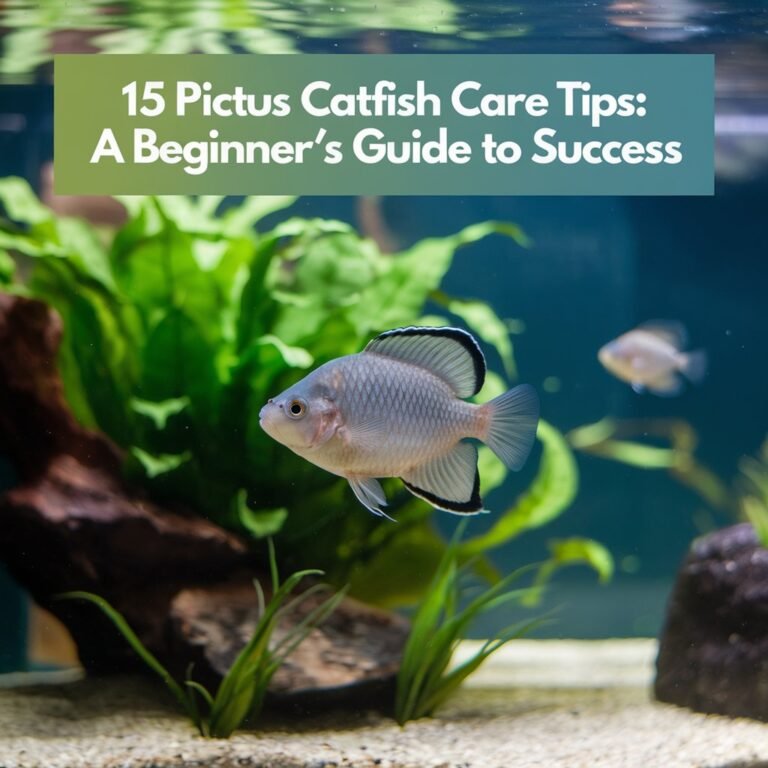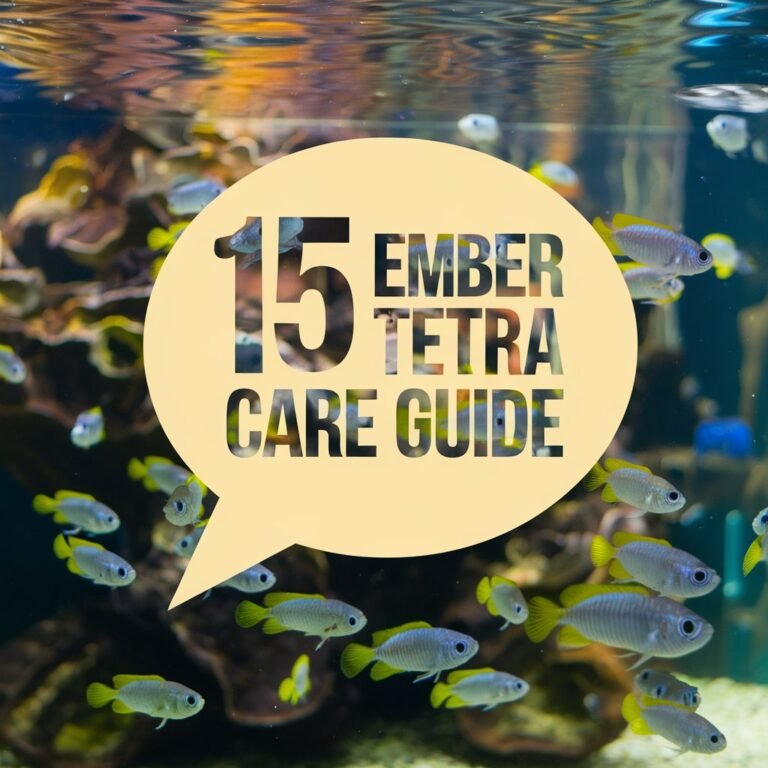15 Care Guide for White Cloud Mountain Minnows
If you’re considering bringing White Cloud Mountain Minnows into your home, you’re making an excellent choice – they’re active, peaceful, and relatively low-maintenance. However, to safeguard their well-being and longevity, vital that you understand their specific needs.
A well-set-up tank is just the beginning; you’ll also need to maintain prime water quality, temperature, and provide a balanced diet. But what does that really mean in practice? By following the right guidelines, you can create a thriving environment for your minnows, but pivotal to know the key factors to focus on – and that’s exactly what we’ll explore next.
In A Nutshell

- Maintain a minimum tank size of 20 gallons with a length of at least 48 inches for White Cloud Mountain Minnows.
- Keep water pH between 6.0 and 8.0, with a water hardness of 5-20 dGH for optimal minnow health.
- Provide cooler temperatures, ranging from 64°F to 75°F (18°C to 24°C), and maintain consistency.
- Feed a balanced diet consisting of high-quality flake food, live foods, and vegetable-based foods, 2-3 times a day.
- Include hiding places, such as plants, rocks, and driftwood, and select peaceful tankmates with similar water requirements.
Choosing the Right Tank Size
When setting up a tank for White Cloud Mountain Minnows, you’re fundamentally creating their environment, so it’s crucial to choose the right tank size.
For a shoaling species like White Cloud Mountain Minnows, a long, wide tank is more suitable than a tall, narrow one. A minimum tank size of 20 gallons is recommended, with a length of at least 48 inches to provide ample swimming space.
A wider aquarium shape also promotes better water circulation and oxygenation.
When selecting tankmates for your White Cloud Mountain Minnows, consider their peaceful nature and small size.
They’re compatible with other peaceful, small fish species that thrive in similar water conditions. Avoid keeping them with fin-nippers or aggressive fish that may harass or outcompete them for food.
Research compatible species and their specific needs to guarantee a harmonious community. A well-planned tank with suitable tankmates will help create a stress-free environment for your White Cloud Mountain Minnows to thrive.
Water Quality and Parameters
To keep White Cloud Mountain Minnows healthy and thriving, you must maintain ideal water quality and parameters in their tank.
These fish are relatively adaptable, but they still require specific conditions to flourish. With regards to pH levels, White Cloud Mountain Minnows prefer a slightly acidic to neutral range, between 6.0 and 8.0. Vital to maintain stable pH levels, as sudden fluctuations can cause stress and illness.
Water hardness is another key parameter to take into account. White Cloud Mountain Minnows thrive in soft to moderately hard water, with a recommended range of 5-20 dGH.
You can achieve this by using a water conditioner to remove minerals and heavy metals from the tap water. Regular water changes (about 10-15% every week) will also help maintain prime water quality.
Monitoring water parameters is vital to prevent water quality issues. You should invest in a reliable water test kit to track pH levels, ammonia, nitrite, and nitrate levels.
Setting Up the Aquarium
Your aquarium setup plays a crucial role in creating a thriving environment for your White Cloud Mountain Minnows.
When designing your aquarium, consider a setup that mimics the minnows’ natural habitat. For a school of 6-10 White Cloud Mountain Minnows, a 10-20 gallon tank is recommended. The tank’s length should be at least 24 inches to provide ample swimming space.
In terms of aquarium design, a longer tank is preferred over a taller one. This allows for better water circulation and provides your minnows with a more stable environment.
When choosing a substrate, opt for a fine-grained material like sand or a neutral-colored gravel. Avoid using a substrate with sharp edges or rough texture that can cause injury to your minnows.
To create a visually appealing environment, use decorative backgrounds that resemble the minnows’ natural habitat.
You can also add plants, rocks, and driftwood to provide hiding places and visual interest.
Avoid overcrowding the tank with decorations, as this can lead to reduced swimming space and increased stress on your minnows.
Proper Water Temperature
Maintaining proper water temperature is crucial for the health and well-being of White Cloud Mountain Minnows. These fish are native to China and prefer cooler temperatures, ranging from 64°F to 75°F (18°C to 24°C).
You should aim to maintain a consistent temperature within this range to guarantee peak health.
In their natural habitat, White Cloud Mountain Minnows experience cooler winter temperatures, which can drop to around 50°F (10°C). However, in a home aquarium, it’s imperative to maintain a stable temperature, avoiding sudden drops or rises.
Temperature fluctuations can cause stress, leading to illness and disease.
To achieve a stable temperature, you should use a high-quality aquarium heater and thermometer. Regularly check the temperature and adjust the heater as necessary.
Avoid placing the aquarium near windows, radiators, or air conditioning units, as these can cause temperature fluctuations.
Feeding White Cloud Minnows
High-quality flake food forms the core of a nutritious diet for White Cloud Mountain Minnows, and it’s what you should offer as their main staple.
You’ll want to supplement their diet with live foods 2-3 times a week to provide variety and essential nutrients. Live foods such as brine shrimp, daphnia, and bloodworms are excellent options. When feeding live foods, make sure to only offer what your minnows can consume within a few minutes to prevent overfeeding and water quality issues.
It’s essential to establish a consistent feeding schedule to guarantee your White Cloud Mountain Minnows receive the nutrients they need.
Feed your minnows 2-3 times a day, only offering what they can consume within 1-2 minutes. This will help maintain superior water quality and prevent overfeeding.
Be mindful of your minnows’ age, size, and activity level when determining their feeding schedule. As they grow and mature, their nutritional needs may change, and you’ll need to adjust their diet accordingly.
Best Foods for Minnows
When selecting the best foods for your White Cloud Mountain Minnows, consider their nutritional requirements and the benefits of various food types.
These omnivorous fish thrive on a diet that includes a mix of plant-based and protein-rich foods. You can opt for commercial flake or pellet foods specifically formulated for small omnivorous fish.
However, supplementing their diet with live or frozen foods can provide vital nutrients.
Live foods, such as brine shrimp or daphnia, are rich in protein and can help stimulate your minnows’ natural hunting behavior.
Frozen brine shrimp or bloodworms are also excellent alternatives, as they’re nutrient-rich and easy to store.
You can also provide your minnows with vegetable-based foods like spirulina or algae wafers.
To guarantee they receive a broad spectrum of nutrients, make certain to vary their diet.
Aim to provide a mix of 2-3 different food types per day, and rotate them regularly to prevent nutritional deficiencies.
By offering a diverse and nutrient-rich diet, you can promote the overall health and well-being of your White Cloud Mountain Minnows.
Rotate foods daily to keep their diet interesting and prevent boredom.
Avoiding Overfeeding
To prevent overfeeding, it’s vital to monitor your White Cloud Mountain Minnows’ food intake closely, as they can eat small amounts frequently throughout the day.
Overfeeding can lead to digestive issues, poor water quality, and even death.
You should determine the ideal food quantity for your minnows based on their age, size, and activity level.
Generally, these fish can thrive on 2-3% of their body weight in food per day.
Break this daily ration into 2-4 smaller meals to maintain stable water conditions and prevent overfeeding.
Feeding frequency also plays a critical role in preventing overfeeding.
White Cloud Mountain Minnows can eat small amounts frequently, but they don’t need to eat constantly.
Limit feeding to twice or thrice a day, and only provide food that can be consumed within 1-2 minutes.
This will help prevent leftover food from decomposing in the tank and affecting water quality.
Monitor your minnows’ behavior and adjust food quantity and feeding frequency accordingly.
If they appear lethargic or show no interest in food, it may be a sign of overfeeding.
Creating a Balanced Diet
With respect to a White Cloud Mountain Minnow’s nutritional requirements, it’s essential you provide a diverse array of foods to guarantee they receive all necessary nutrients.
As a beginner, it’s vital to understand the importance of a balanced diet that meets the fish’s specific needs.
When it comes to creating a balanced diet for your White Cloud Mountain Minnow, it’s recommended that you offer a variety of foods high in nutritional value.
Food variety is essential to prevent boredom and nutritional deficiencies.
Incorporating multiple protein sources is key, including high-quality commercial flake foods, live or frozen brine shrimp, bloodworms, and daphnia.
You should also consider adding some vegetable-based foods to provide fiber and essential vitamins.
In a balanced diet, 70-80% of the food should consist of plant-based and staple foods, while the remaining 20-30% can be high-protein foods like meaty foods.
Aim for 2-3 meals a day and provide a variety of foods in each meal to certify that your fish are getting the necessary nutrients for peak growth and health.
This varied diet won’t only certify that your White Cloud Mountain Minnow flourish, but it’ll also bring out their natural colors and enhance their overall appearance.
Providing Hiding Places
Incorporating hiding places into your White Cloud Mountain Minnow’s aquarium setup is essential for reducing stress and providing them a sense of security.
You can achieve this by adding decorative plants with dense foliage, such as Java moss or Anacharis, which will provide ample hiding spots for your minnows.
These plants also help maintain water quality by absorbing excess nutrients and reducing algae growth.
Rock formations are another effective way to create hiding places for your White Cloud Mountain Minnows.
You can arrange rocks of varying sizes to create caves, tunnels, and crevices that provide shelter and security.
Make sure to leave enough space between the rocks for your minnows to swim through comfortably.
Avoid using sharp or rough rocks that may cause injury to your fish.
When designing your aquarium, consider the natural habitat of White Cloud Mountain Minnows, which includes rocky streams and rivers with dense vegetation.
Suitable Tankmates
When selecting tankmates for your White Cloud Mountain Minnows, you’ll want to choose species that share similar water requirements and temperaments.
White Cloud Mountain Minnows are peaceful, active swimmers that thrive in schools, so it’s best to pair them with other peaceful species that won’t harass or compete with them for food. Avoid keeping them with aggressive species, such as fin-nippers or territorial fish, as this can cause stress and lead to disease.
Peaceful schools of small fish, such as Harlequin Rasboras, Zebra Danios, or Cherry Barbs, make excellent tankmates.
These species are easy to care for and can tolerate the same water conditions as White Cloud Mountain Minnows. You can also consider keeping them with snails, shrimp, or other peaceful invertebrates.
When introducing tankmates, do it slowly and under close observation to guarantee a seamless shift. A general rule of thumb is to stock peaceful species first and then add the more active or competitive species later.
This will help establish a harmonious community and reduce the risk of conflicts. By choosing the right tankmates, you can create a thriving and diverse aquarium.
Setting Up Water Circulation
Effective water circulation is pivotal for maintaining ideal water quality and the overall health of your White Cloud Mountain Minnows.
When setting up your aquarium, having a system that efficiently circulates water throughout the tank is imperative. This can be achieved by strategically placing equipment such as powerheads and filters.
Powerhead placement is key in creating the desired water circulation. You should position them in a way that creates a gentle, yet consistent flow of water throughout the tank.
Aim to create a circulation pattern that prevents stagnant areas and promotes water turbulence. Water turbulence helps to distribute heat, oxygen, and nutrients evenly, which is beneficial for the health and well-being of your White Cloud Mountain Minnows.
When positioning powerheads, consider the tank’s dimensions and the location of plants, decorations, and other equipment. Avoid placing powerheads near the surface, as this can create excessive water agitation and lead to jumping.
Instead, position them near the mid-water level or closer to the substrate to create a more subtle, yet effective circulation pattern.
Maintaining Good Water Flow
Maintaining ideal water flow is essential for the long-term health and well-being of your White Cloud Mountain Minnows.
As a beginner aquarist, it’s pivotal to guarantee your aquarium has a suitable water circulation system to create a prime environment. You should focus on fine-tuning Water Pump Placement, positioning them strategically to achieve the best flow.
Placing a pump in the corner or along a side will allow it to generate the required water movement to benefit your minnows. Make sure that you point the outlet nozzles or direction pipes of your water pumps so as not to create areas of stagnant water or strong currents.
To prevent water stagnation, your aquarium’s Filter Output should be set to a moderate to high flow rate, with a minimum of 10-15 gallons per hour.
This guarantees the entire aquarium gets sufficient water circulation and oxygenation, supporting the health of your White Cloud Mountain Minnows. Effective circulation not only provides an active and interesting swimming area but also facilitates food delivery to the surface or to food collector filters for even nutrition.
Monitoring Water Changes
As you endeavor to create a perfect environment for your White Cloud Mountain Minnows, regular water changes are crucial to their health and well-being.
To guarantee the water quality remains superior, you’ll need to establish a routine for monitoring water changes. This involves creating a water testing schedule to track the aquarium’s water parameters.
You should test the water for ammonia, nitrite, and nitrate levels at least once a week. Additionally, you’ll want to monitor the pH and temperature levels daily.
By doing so, you’ll be able to identify any fluctuations in the water parameters and make adjustments accordingly. To certify proper maintenance, maintain a record of your water tests, which can be done through aquarium logging.
This will help you track any changes in the water parameters over time and make informed decisions about your aquarium’s maintenance.
Recognizing Common Diseases
While regularly testing your aquarium’s water parameters will help prevent disease, even the most well-maintained tank can still fall victim to certain illnesses.
As a responsible White Cloud Mountain Minnow owner, it’s vital to recognize common diseases that can affect your fish.
Fungal infections are a common issue in aquariums, often caused by poor water quality or injury to the fish.
Look for visible signs of fungal growth, such as white, cotton-like patches on the fish’s body or fins. Fungal infections can be treated with antifungal medications, but it’s imperative to address the underlying cause to prevent reoccurrence.
Bacterial blooms can also affect your White Cloud Mountain Minnows, often caused by an overabundance of nutrients in the water.
This can lead to a range of symptoms, including labored breathing, lethargy, and visible signs of bacterial growth, such as cloudy or discolored water.
Regular water changes and monitoring of water parameters can help prevent bacterial blooms.
If you suspect a bacterial bloom, perform a partial water change and consider adding a bacterial supplement to your tank.
Breeding White Cloud Minnows
Breeding White Cloud Minnows in a controlled environment requires a well-planned setup and attention to detail.
You’ll need a separate breeding tank with a capacity of at least 10 gallons, equipped with a secure lid, as these fish are skilled jumpers. Maintain a temperature range of 64-75°F (18-24°C) and pH between 6.0-7.0.
Provide plenty of hiding places and plants, such as Java moss or Anacharis, to create a natural environment.
To induce breeding, you’ll need to simulate the fish’s natural breeding triggers. You can achieve this by performing a partial water change (about 50%) with cooler water, which will trigger spawn induction.
You can also try adding a small amount of peat or oak leaves to the water to mimic the natural environment. Increase the frequency of water changes and maintain ideal water parameters to encourage the fish to breed.
Once the female is ready to spawn, she’ll display a swollen belly, and the male will start displaying courtship behavior. Monitor the fish closely, as the eggs will be scattered among the plants, and remove them to a separate tank to prevent predation.
Frequently Asked Questions
Can I Keep White Cloud Minnows With Neon Tetras Together?
You can keep White Cloud Minnows with Neon Tetras, as they’re compatible school mates. Both species thrive in cooler temperatures and peaceful environments, making them suitable tank mates for a harmonious community aquarium setup.
Are White Cloud Minnows Considered Good Parents to Their Eggs?
When keeping white cloud minnows, you’ll find they’re naturally poor egg guardians due to their limited parental instincts and social schooling behaviors. Observe their spawning habits and notice how little egg protection they offer.
How Do I Introduce New White Cloud Minnows to an Existing Tank?
When introducing new White Cloud Minnows, you’ll need to guarantee tank acclimation by floating the unopened bag for 15-20 minutes, then releasing the fish. Verify species compatibility to prevent conflicts and maintain a harmonious environment.
Can White Cloud Minnows Jump Out of a Normal Aquarium Tank?
When managing your aquatic ecosystem, be aware that white cloud minnows can perform impressive fish acrobatics and might attempt an aquatic escape from a standard aquarium tank, as they’re known to be capable jumpers, you must take preventative measures.
Are White Cloud Minnows a Good Choice for a Small Community Tank?
You’ll find White Cloud Minnows suitable for small community tanks, given their peaceful nature and schooling behavior. However, they require a minimum tank size of 10 gallons to accommodate their active swimming and social needs effectively.
FInal Verdict
By following the guidelines outlined in this care guide, you’ll be well on your way to creating a thriving environment for your White Cloud Mountain Minnows. Remember to monitor water parameters closely, maintain a record of water tests, and make adjustments as necessary.
Regular water changes, a balanced diet, and proper tank setup are key to keeping your minnows healthy and stress-free. Stay vigilant and take prompt action at the first sign of disease or water quality issues.

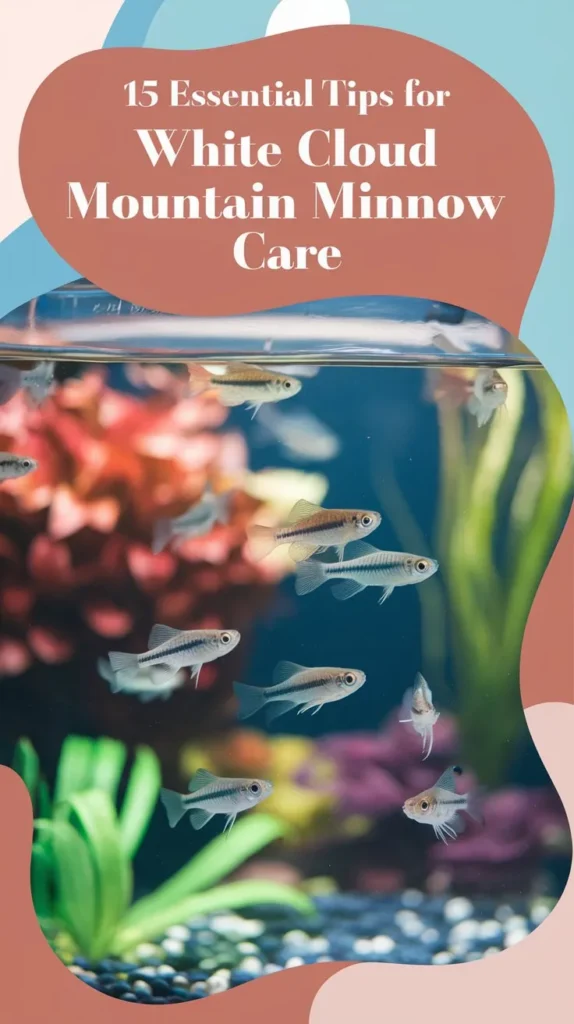




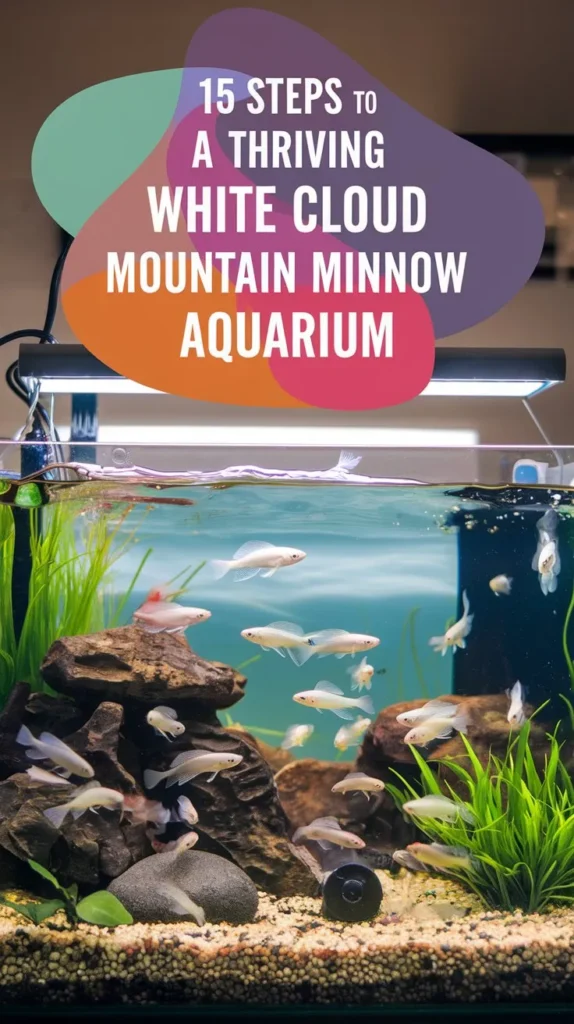
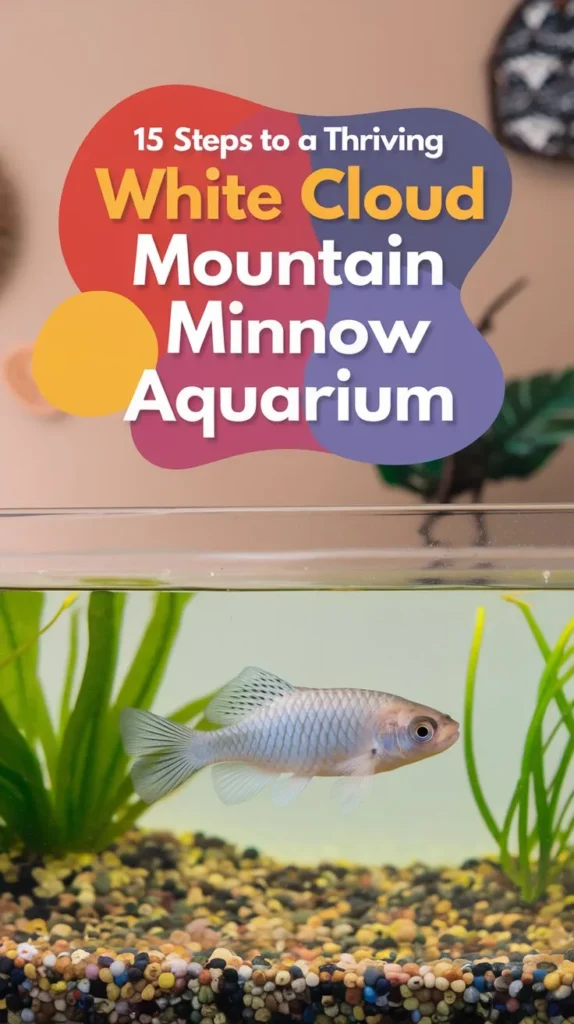


Hello, I’m Aria Cooper, the heart and soul behind Swimmy Buddies. As a devoted fish aficionado, I share my aquatic adventures and expertise to inspire your own underwater explorations. 🐠🌊

